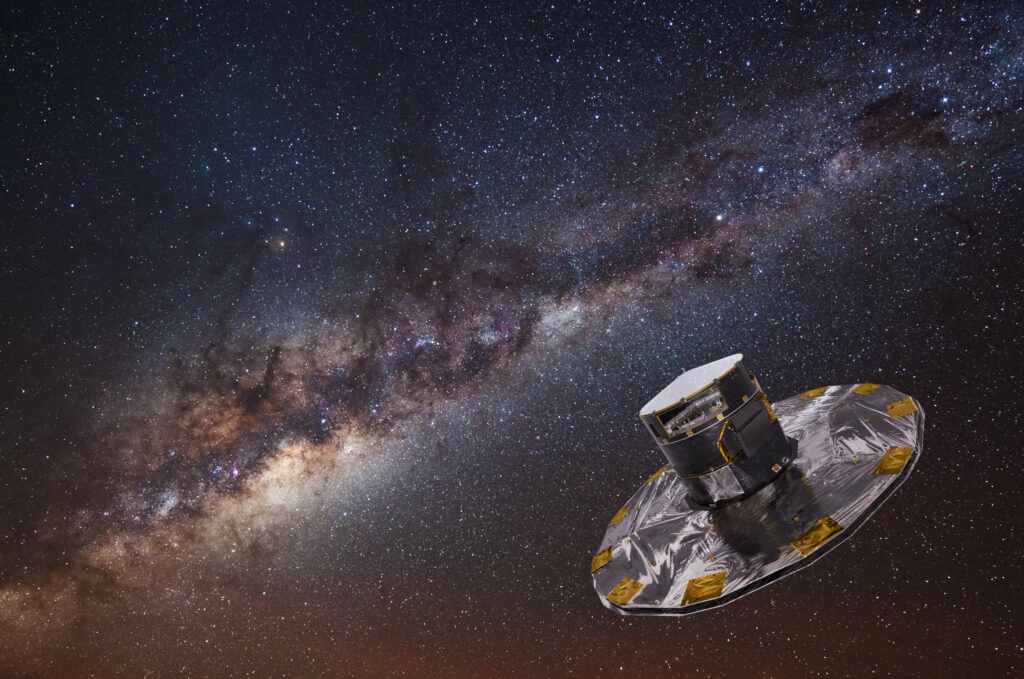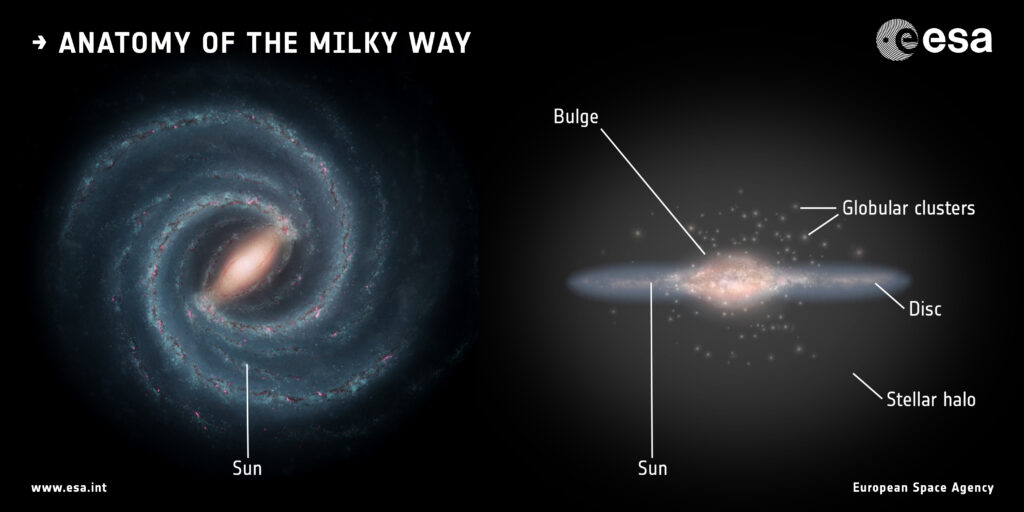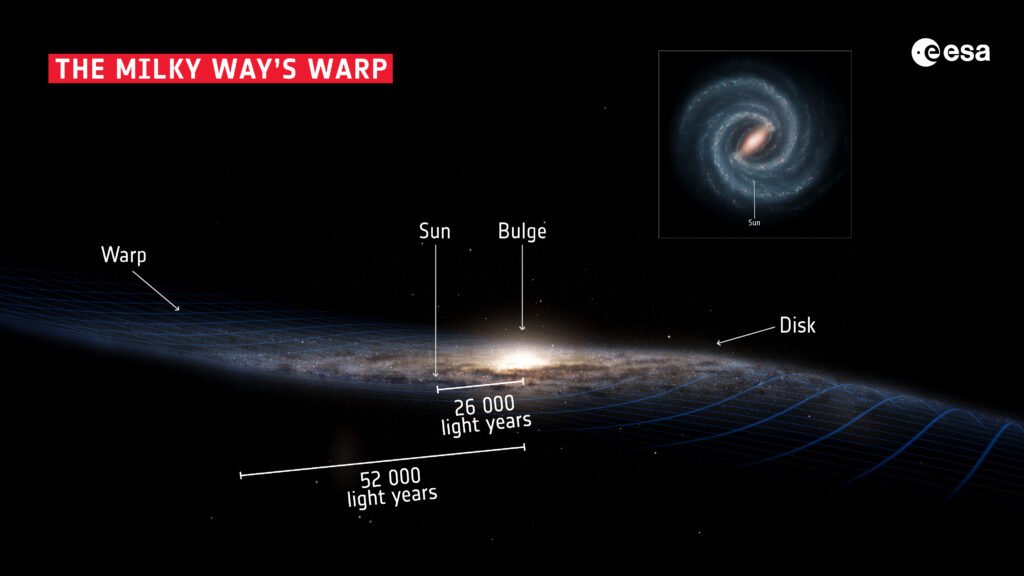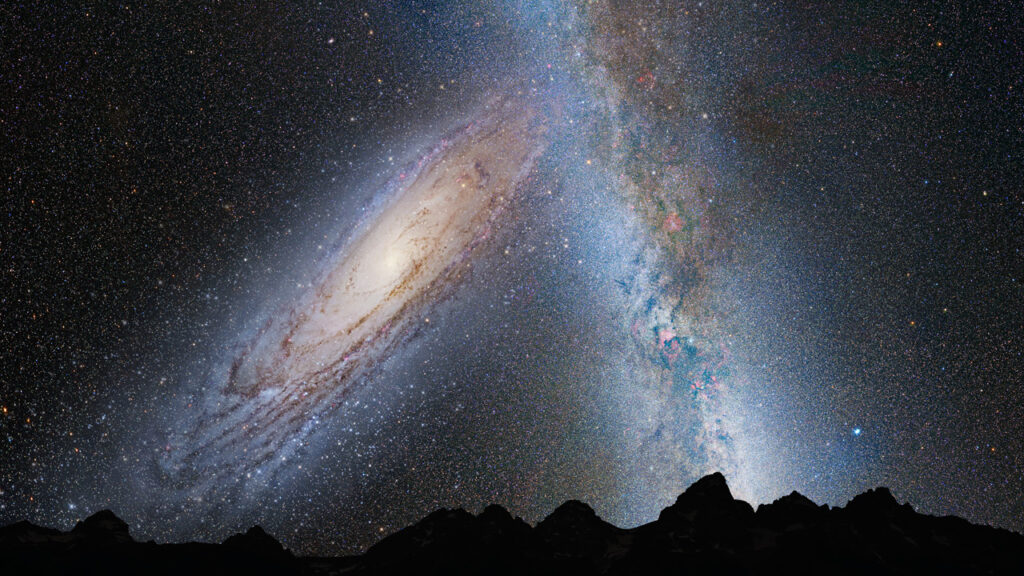Journey Through Our Galactic Home
© ESA/Gaia/DPAC
The Milky Way Galaxy, a vast spiral system containing hundreds of billions of stars, is approximately 13.6 billion years old. It derives its name from the luminous, irregular band of stars and gas clouds that graces our night sky, visible as a band due to our perspective from within the disk-shaped structure. Galileo Galilei first discerned individual stars within this band using his telescope in 1610. Until the early 1920s, many astronomers believed the Milky Way Galaxy encompassed all the stars in the Universe.
Much like Earth orbits the Sun, our solar system orbits the center of the Milky Way Galaxy. Despite hurtling through space at incredible speeds, roughly 515,000 miles per hour (828,000 kilometers per hour), a single revolution takes an astonishing 250 million years. The last time we occupied this position, dinosaurs were just emerging and mammals had yet to evolve.
Our Solar System is positioned about 27,000 light-years (8.3 kiloparsecs) from the Galactic Center, situated on the inner edge of the Orion Arm—a spiral-shaped concentration of gas and dust. Stars within the innermost 10,000 light-years form a bulge, and one or more bars extend outward from it. At the heart of the Galactic Center lies Sagittarius A*, an intense radio source, which houses a supermassive black hole with a mass of approximately 4.1 million times that of our Sun. Stars and gases, distributed over a wide range of distances from the Galactic Center, orbit at a staggering speed of about 220 kilometers per second (136 miles per second).
Contrary to common belief, the Milky Way Galaxy is not orbiting any central point, such as the center of the universe, and therefore lacks a distinct orbital period. Instead, it spins akin to a frisbee, propelled forward in a straight trajectory from the moment of the Big Bang, which transpired 14 billion years ago. Similarly, all other galaxies in the universe originated from the Big Bang, journeying on their individual, unintersecting paths, resembling spokes on a cosmic wheel.
FORMATION OF MILKY WAY GALAXY

The genesis of the Milky Way Galaxy is a nuanced and intricate journey that spanned billions of years. It can be distilled into several pivotal stages:
- Big Bang and Primordial Elements (Approx. 13.8 Billion Years Ago): The universe began with the Big Bang, a colossal explosion that created space, time, and matter. Initially, only basic elements like hydrogen and helium were formed.
- Formation of the First Stars (Approx. 100-400 Million Years After Big Bang): The first stars, known as Population III stars, began to form within massive clouds of primordial gas. These early stars were composed almost entirely of hydrogen and helium.
- Nuclear Fusion and Supernova Explosions (Approx. 100 Million to a Few Billion Years After Big Bang): Population III stars underwent nuclear fusion, generating heavier elements. When these massive stars reached the end of their lifecycles, they exploded in supernovae, dispersing these newly formed elements into space.
- Formation of the Milky Way’s Halo (Approx. 13.2 Billion Years Ago): The Milky Way Galaxy’s halo began to form from the remnants of early supernovae. This spherical region around the galactic center contains some of the oldest stars in the galaxy.
- Formation of the Galactic Disk (Approx. 12-13 Billion Years Ago): The gravitational collapse of gas clouds within the halo led to the formation of the galactic disk. Stars formed in this region became part of the disk’s stellar population.
- Spiral Arm Formation (Approx. 8-10 Billion Years Ago): Density waves within the disk led to the formation of the Milky Way’s characteristic spiral arms. These regions exhibited higher stellar density and served as fertile grounds for star formation.
- Globular Cluster Formation (Approx. 12-13 Billion Years Ago): Dense, spherical collections of stars known as globular clusters formed in the Milky Way’s halo. These clusters are among the oldest structures in the galaxy.
- Continued Stellar Evolution and Galactic Interactions (Over Billions of Years): The Milky Way Galaxy continued to evolve, with stars forming, aging, and sometimes undergoing supernova explosions. The galaxy also experienced interactions with other galaxies, leading to the acquisition of stars, gas, and potentially even merging events.
- Present Day (Approx. 13.8 Billion Years After Big Bang): The Milky Way Galaxy has reached its current state, with a central bulge, spiral arms, a galactic disk, and a surrounding halo. It continues to evolve, and our solar system resides in one of its spiral arms.
STRUCTURE

The Milky Way Galaxy encompasses a core region in the form of a bar, encircled by a warped disk comprising gas, dust, and stars. Its mass distribution aligns closely with the Hubble classification of type Sbc, representing spiral galaxies with moderately open arms. The notion that the Milky Way Galaxy is a barred spiral galaxy, rather than a typical spiral galaxy, emerged in the 1960s and was later substantiated by observations from the Spitzer Space Telescope in 2005, revealing a central bar larger than previously envisioned.
GALACTIC CENTER
The Sun resides at a distance of approximately 25,000–28,000 light years (7.7–8.6 kiloparsecs) from the Galactic Center. In the innermost kiloparsecs, about a radius of 10,000 light-years, there exists a dense aggregation of predominantly aged stars forming a roughly spheroidal shape known as the bulge. Some theories posit that the Milky Way Galaxy’s bulge may be a pseudobulge formed by its central bar, potentially due to previous galaxy collisions and mergers. Nevertheless, there exists a notable ambiguity in the literature, distinguishing between the (peanut shell)-shaped structure created by instabilities in the bar, and a potential bulge with an anticipated half-light radius of 0.5 kiloparsecs.
Sagittarius A* (Sgr A*) is a supermassive black hole nestled at the core of the Milky Way Galaxy, approximately 26,000 light-years from Earth. Remarkably, it boasts a mass equivalent to 4.3 million times that of our Sun, yet occupies a minuscule volume. Despite its compactness, Sgr A* wields immense gravitational influence, orchestrating the intricate dance of stars in its vicinity. This cosmic heavyweight emits powerful radiation, particularly in X-ray and radio frequencies, providing astronomers with vital insights into the behaviour of supermassive black holes.
At the heart of the Milky Way Galaxy lies the Galactic Center, a bustling epicenter of cosmic activity. It emits intense X-ray and radio frequencies, unveiling profound astrophysical phenomena. At the forefront is Sagittarius A* (Sgr A*), the supermassive black hole, which prominently generates X-rays as matter plunges into its gravitational maw. Moreover, the interplay of hot gas, stellar winds, and potent magnetic fields contributes to these emissions. Within the radio frequency spectrum, synchrotron radiation emerges from charged particles, accelerated and spiraling along magnetic field lines. Since 1970, missions detecting gamma rays have revealed 511-keV gamma rays originating from the Galactic Center. These gamma rays result from the annihilation of positrons (antielectrons) with electrons.
SPIRAL ARMS
Beyond the gravitational sway of the Galactic bar, the interstellar medium and stars within the Milky Way Galaxy’s disk are arranged into four distinct spiral arms. These arms are characterized by a heightened density of interstellar gas and dust, surpassing the Galactic average, and host a more concentrated zone of star formation.
The dense environments of spiral arms are conducive to the formation of new stars. Massive clouds of gas and dust within these arms collapse under their own gravity, giving rise to clusters of young stars. Stars within a spiral arm don’t permanently reside there. Instead, they move in and out of the arms as they orbit the galactic center. This motion can be likened to cars on a highway, with stars “entering” and “exiting” the spiral arms.
Our solar system, including Earth, resides in a spiral arm of the Milky Way Galaxy known as the Orion Arm, sometimes referred to as the Local Arm. This region is about 3,500 light-years wide and is located between two major spiral arms, the Sagittarius Arm and the Perseus Arm. The Orion Arm is rich in star-forming regions, which has favoured the development of life on Earth. It’s a bustling neighbourhood in our galaxy, containing a diverse array of stars, star clusters, and other celestial phenomena.
A simulation from 2011 posited that the Milky Way Galaxy’s spiral arm structure may have been shaped by repeated collisions with the Sagittarius Dwarf Elliptical Galaxy. Some theories suggest that our galaxy encompasses two distinct spiral patterns: an inner one, forged by the Sagittarius arm, rotating swiftly, and an outer pattern, sculpted by the Carina and Perseus arms, characterized by a slower rotation and tightly wound arms. According to numerical simulations of the dynamics of these spiral arms, the outer pattern would form an outer pseudoring, linked to the inner pattern by the Cygnus arm.
Beyond the major spiral arms lies the Monoceros Ring, a ring of gas and stars originating from other galaxies billions of years ago. Nonetheless, some members of the scientific community have recently maintained the stance that the Monoceros structure is merely an over-density produced by the flared and warped thick disk of the Milky Way. The disk’s structure exhibits a warp along an “S” curve.
Studies of other galaxies indicate that spiral arms generally conform to a logarithmic spiral form, expressed as: log r = a − bϕ,
Here, ϕ represents a position angle measured from the center to the outermost part of the arm, r signifies the distance from the center of the galaxy, and ‘a’ and ‘b’ are constants.
HALO
The Galactic disk, a flat and revolving expanse within the Milky Way Galaxy, is enveloped by a spheroidal halo containing aged stars and globular clusters. Approximately 90% of these clusters are situated within 100,000 light-years (30 kiloparsecs) of the Galactic Center. Notably, around 40% of the Milky Way Galaxy’s clusters follow retrograde orbits, signifying their movement in the opposite direction of the galaxy’s rotation.
The halo is believed to be embedded in a much larger and diffuse halo of dark matter. Although dark matter cannot be directly observed, its gravitational influence on visible matter, such as stars and gas, is evident.
In the early 21st century, pivotal discoveries expanded our understanding of the Milky Way Galaxy’s structure. The revelation that the disk of the Andromeda Galaxy (M31) extends much farther than initially thought raises the possibility of a similar extension for our own galaxy. This is reinforced by the findings of the Outer Arm extension of the Cygnus Arm and a comparable extension of the Scutum–Centaurus Arm.
The unearthing of the Sagittarius Dwarf Elliptical Galaxy led to the identification of a ribbon of galactic debris, a result of the dwarf’s polar orbit and its interaction with the Milky Way Galaxy, which causes it to disintegrate. Similarly, the discovery of the Canis Major Dwarf Galaxy unveiled a ring of galactic debris encircling the Galactic disk, formed through its interaction with our own galaxy.
GALACTIC DISK
The galactic disk is a defining feature of the Milky Way Galaxy, constituting the prominent, flattened region that encompasses the majority of the galaxy’s visible mass. This dynamic expanse is a bustling cosmic arena, teeming with a diverse array of celestial constituents, including stars, gas, dust, and other celestial matter. Its flat, circular shape extends outwards from the galactic center, forming a vast plane that spans tens of thousands of light-years in diameter.
Within the galactic disk, a rich tapestry of stellar populations takes center stage. This region is home to an extensive assembly of stars, ranging from young, luminous giants to mature, sun-like stars and beyond. Our very own Sun, a middle-aged star, resides in this bustling domain. These stars are intricately connected by the gravitational dance they perform, as they collectively orbit the central core of the galaxy.
One of the most notable attributes of the galactic disk is its role as a crucible for star formation. Within this fertile breeding ground, immense molecular clouds of gas and dust collide and coalesce, succumbing to their own gravitational pull. This spectacular process births new generations of stars, often in stellar nurseries nestled within vast regions of interstellar dust and gas. The thinnest component, often called the “thin disk,” includes the dust and gas and the youngest stars, while a thicker component, the “thick disk,” includes somewhat older stars.
SIZE AND MASS

SIZE
The Milky Way Galaxy is one of the two largest galaxies in the Local Group (the other being the Andromeda Galaxy), although the size for its galactic disc and how much it defines the isophotal diameter is not well understood. It is estimated that the significant bulk of stars in the galaxy lies within the 100,000 light-years diameter, and that the number of stars beyond the outermost disc dramatically reduces to a very low number, with respect to an extrapolation of the exponential disk with the scale length of the inner disc.
The galactic disk, where most of the stars and interstellar matter reside, is relatively thin compared to its diameter. It has an approximate thickness of about 1,000 light-years. Stars in the disk are dispersed in clouds of stellar dust and gas. When we look up to the sky at night, it’s the edge-on view of this disk extending toward the galactic center that takes our breath away.
MASS
The total mass of stars in the Milky Way Galaxy is estimated to be around 100 to 400 billion times that of our Sun. This constitutes only a fraction of the overall mass of the galaxy. Including the dark matter, estimates for the total mass of the Milky Way Galaxy range from about 700 billion to 1.5 trillion times the mass of the Sun.
The galaxy’s visible matter is distributed between its 200 billion stars, their planets and the massive clouds of dust and gas that fill the interstellar space. Much of the mass of the Milky Way Galaxy seems to be dark matter, an unknown and invisible form of matter that interacts gravitationally with ordinary matter. A dark matter halo is conjectured to spread out relatively uniformly to a distance beyond one hundred kiloparsecs (kpc) from the Galactic Center.
GALACTIC NEIGHBOURHOOD

The Galactic Neighbourhood of the Milky Way Galaxy encompasses a region in space that extends from our solar system to a few tens of thousands of light-years away. Within this local expanse, a rich tapestry of celestial objects and phenomena come together, offering astronomers a unique vantage point to explore the diverse components of our cosmic surroundings.
STELLAR POPULATION
At the heart of the Galactic Neighbourhood are the stars. Some of the nearest stars to our solar system include Proxima Centauri, a red dwarf star located approximately 4.24 light-years away. This makes it the closest known star to the Sun. Alpha Centauri A and B, forming a binary system, are also close neighbors, situated around 4.37 light-years from us. Sirius, the brightest star in our night sky, resides about 8.6 light-years away. These stars, among others, form a part of the neighborhood’s stellar ensemble.
STELLAR GROUPS AND CLUSTERS
The Galactic Neighborhood is adorned with a variety of star clusters and groups. The Hyades Cluster, located about 153 light-years away, is a prominent open star cluster and one of the nearest to our solar system. It contains over a hundred stars, including Aldebaran, which is not physically associated with the cluster but appears in the same line of sight. Another well-known cluster in the neighbourhood is the Pleiades, or Seven Sisters, situated about 444 light-years away. It is a young cluster, with some stars still surrounded by remnants of their birth material. These clusters are crucial in our understanding of stellar formation, as they are comprised of stars that share a common origin from the same molecular cloud.
GAS AND DUST CLOUDS
The Galactic Neighbourhood is replete with interstellar clouds, composed of gas (predominantly hydrogen and helium) and dust. These clouds can range from vast molecular complexes to smaller, denser regions. The Orion Molecular Cloud Complex, located approximately 1,500 light-years away, is one of the most prominent and active star-forming regions in the neighbourhood. It is home to the Great Orion Nebula (M42), a stunning cosmic nursery where new stars are actively taking shape. Additionally, the Ophiuchus Molecular Cloud, found about 450 light-years from us, harbours young stellar objects in various stages of evolution, from protostellar to pre-main sequence.
DWARF GALAXIES
Satellite galaxies in orbit around the Milky Way Galaxy populate the Galactic Neighbourhood. These dwarf galaxies are substantially smaller in size compared to our Milky Way Galaxy and often exhibit distinctive properties. The Large and Small Magellanic Clouds, located at distances of approximately 160,000 and 200,000 light-years respectively, are two of the most notable dwarf galaxies in our vicinity. Despite their smaller stature, these galaxies have left significant imprints on the Milky Way Galaxy’s history through their gravitational interactions.
EXOPLANETARY SYSTEMS
The study of exoplanetary systems, or planetary systems around stars other than our Sun, has emerged as a central focus of contemporary astronomy. Within the Galactic Neighbourhood, researchers have made numerous breakthroughs in identifying and characterizing exoplanets. One notable discovery is the Trappist-1 system, located approximately 39 light-years away. This system gained international attention for its seven Earth-sized planets, several of which orbit within the star’s habitable zone, where conditions might be conducive to liquid water.
TRANSIENT PHENOMENA
The Galactic Neighbourhood also provides a front-row seat to transient events in the cosmos. One such event is the supernova, a cataclysmic explosion that marks the end of a massive star’s life cycle. While supernovae are relatively rare occurrences, they play a pivotal role in shaping galaxies and their environments. These powerful explosions release immense amounts of energy and are responsible for dispersing heavy elements into space, which can later become part of new stellar systems.
